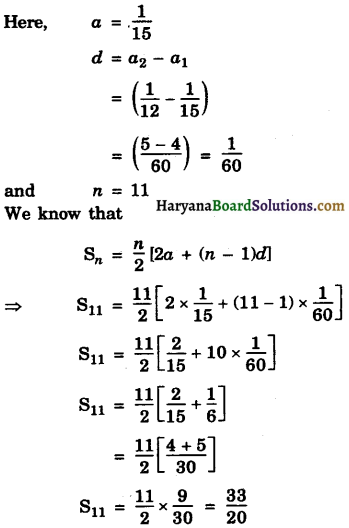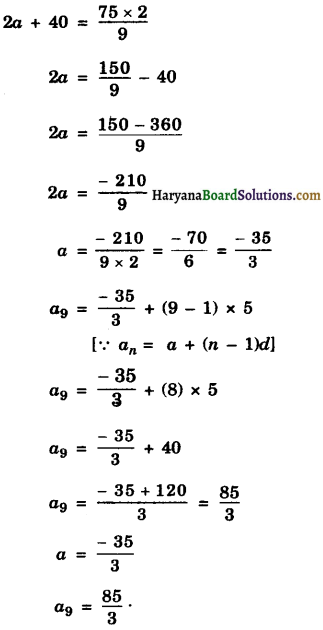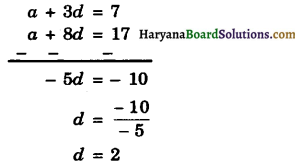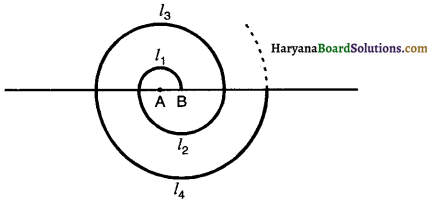HBSE 6th Class English Solutions Honeysuckle Chapter 8 A Game of Chance
Haryana State Board HBSE 6th Class English Solutions Honeysuckle Chapter 8 A Game of Chance Textbook Exercise Questions and Answers.
Haryana Board 6th Class English Solutions Honeysuckle Chapter 8 A Game of Chance
HBSE 6th Class English A Game of Chance Textbook Questions and Answers
A. Complete the following sentences from memory choosing a phrase from those given in brackets:
1.______was held at the time of the Eid festival. (A big show, A big fair, A big competition)
2. Tradesmen came to the village with all kinds of goods ______ . (to display, to buy, to sell)
3. Uncle told me ______ while he was away. (not to buy anything, not to go anywhere, not to talk to anyone)
4. The owner of the Lucky Shop wanted everybody present ______ . (to play the game, to win a prize, to try their luck)
5. The The first time I took a chance I got ______. (a bottle of ink, two pencils, a trifle)
6. Uncle told me that the shopkeeper had made ______ . (a fool of me, a good profit, friends with many people)
Answer:
1. A big fair was held at the time of the Eid festival.
2.Tradesmen came to the village with all kinds of goods to sell.
3.Uncle told me not to buy anything while he was away.
4.The owner of Lucky Shop wanted everybody present to try his luck.
5. The first time I took a chance I got two pencils.
6.Uncle told me that the shopkeeper had made a fool of me.
![]()
B. Answer the following questions:
A Game of Chance 6th Class English HBSE Honeysuckle Question and Answer Question 1.
Why do you think Rasheed’s uncle asked him not to buy anything in his absence? (3)
Answer:
Rasheed’s uncle asked him not to buy anything in his absence because he could be made fool of by businessmen.
6th Class English HBSE Honeysuckle Question and Answer A Game of Chance Question 2.
Why was the shop called ‘Lucky Shop’? (4)
Answer:
The shop was called ‘Lucky Shop’ because people tried their luck here.
A Game of Chance Question and Answer 6th Class English HBSE Question 3.
An old man won a clock and sold it back to the shopkeeper. How much money did he make? (5)
Answer:
The old man sold the clock for 15 rupees.
Question 4.
How many prizes did the boy win? What were they? (6)
Answer:
The boy won two pencils, a bottle of ink, a trifle etc.
Question 5.
Why was Rasheed upset? (7,8,9)
Answer:
Rasheed was upset because he had lost money at Lucky Shop.
Question 6.
In what way did the shopkeeper make a fool of Rasheed?
Answer:
The shopkeeper made a fool of Rasheed by giving him a trifle every time. At last Rasheed lost all his money.
![]()
HBSE 6th Class English A Game of Chance Important Questions and Answers
Question 1.
Give a brief account of the Eid Fair.
Ans.
A fair was held in Rasheed’s village on the occasion of Eid. It lasted many days. Tradesmen came there from far and near. They sold all kinds of goods there.
Question 2.
With whom did Rasheed go to the Eid Fair?
Ans.
Rasheed’s uncle took him to the Eid Fair. Their domestic servant, Bhaiya also went with them.
Question 3.
Where did Rasheed’s uncle go?
Ans.
There was a big crowd at the Eid Fair. Rasheed’s uncle was leading them through the crowd. Just then, he met a few of his friends. They wanted to spend some time with Rasheed’s uncle. Rasheed’s uncle asked him and Bhaiya to look around the fair. The uncle went with his friends.
Question 4.
Who managed the ‘Lucky Shop’?
Ans.
A shopkeeper managed the ‘Lucky Shop’. He was neither young nor old. He was a middle aged man. He was neither too smart nor too lazy.
Question 5.
What was the game to be played at the ‘Lucky Shop’?
Ans.
There were discs on the table. They had numbers from one to ten. They were placed facing down. The player had to pay fifty paise. He had to pick up six discs. He had to find the total by adding up the numbers on the discs. He got the article marked with that number.
Question 6.
What did Rasheed do at the Lucky Shop?
Ans.
Rasheed paid 50 paise. He took six discs. He got two pencils., He sold them for 25 paise. He tried again. Then he got a bottle of ink. The shopkeeper also bought it for 25 paise. He took a third chance. Even then, he was a loser. He continued trying his luck. He lost all his money without getting anything.
![]()
Question 7.
How did the people react to Rasheed’s bad luck?
Ans.
Many people were looking at Rasheed when he was losing money. Some people were laughing at his bad luck. Nobody showed any sympathy with him.
A Game of Chance Passages for Comprehension
Passage – 1
Every year………..came with us.
Questions :
(i) When was the fair held in the narrator’s village?
(ii) For how many days was Eid celebrated?
(iii) For how many days did the fair last?
(iv) Why did tradesmen come there?
(v) Who was Bhaiya?
Answers:
(i) The fair was held every year in the narrator’s village on the occasion of Eid.
(ii) Eid was celebrated for only one day.
(iii) The fair lasted many days.
(iv) Tradesmen came there to sell all kinds of goods.
(v) Bhaiya was the narrator’s male servant.
![]()
Passage – 2
Bhaiya and…………was yours.
Questions:
(i) Where did Bhaiya and the narrator go?
(ii) What type of man ran the lucky shop?
(iii) What did he want everybody to do?
(iv) How much money had to be paid by everyone?
(v) Why did he wait for his uncle to return?
Answers:
(i) Bhaiya and the narrator went from shop to shop.
(ii) A middle-aged man ran the lucky shop.
(iii) He wanted everybody to try their luck.
(iv) 50 paise had to be paid by everyone.
(v) He waited for his uncle to return because he liked to buy many things.
Passage – 3
Then a boy, ………….. 10 rupees.
Questions :
(i) What did the boy get?
(ii) How did the shopkeeper look?
(iii) What did the shopkeeper buy the comb for?
(iv) What did the boy get in his next trial?
(a) What was the fountain-pen worth?
Answers :
(i) The boy got a comb worth 25 paise.
(ii) The shopkeeper looked neither happy nor sad.
(iii) The shopkeeper bought the comb for 25 paise.
(iv) In his next trial, the boy got a fountain- pen.
(v) The fountain-pen was worth three rupees.
Passage – 4
I had hopes, ………………. disappeared.
Questions :
(i) Why did the narrator continue trying his luck?
(ii) How much money did he pay each time?
(iii) What did he get every time?
(iv) What happened when the narrator made the last trial?
(v) Use the phrase ‘to settle the account’ in your own sentence.
Answers :
(i) The narrator continued trying his luck because he hoped to win a big prize.
(ii) He paid 50 paise each time.
(iii) Every time he got a trifle.
(iv) The last 25 paise also disappeared when the narrator made the last trial.
(v) I shall settle the account with my parents before I go abroad.
![]()
A Game of Chance Translation in Hindi
1. Every year …………… buffalo.
प्रत्येक साल ईद के अवसर पर हमारे गाँव में मेला हुआ करता था। ईद मात्र एक दिन ही मनाई जाती थी परंतु मेला कई दिन चलता था। व्यापारी सभी प्रकार के मालों के बेचने के लिए चारों ओर से यहाँ आते थे। आप एक छोटी-सी पिन से लेकर बड़ी भैंस तक खरीद सकते थे।
Word-Meanings:
Occasion-chance, STERI Celebrated-performed a ceremony, मनाया। Buffalo-a milk-giving animal, भैंस। Lasted- came to an end, चला। Trades-men businessmen, व्यापारी। Goods-things, माल।
2. Uncle took …………… with them.
चाचाजी मुझे मेले में ले गये थे। भैया जो कि हमारे घर हमारे लिए काम करता था, हमारे साथ आया। मेले में बड़ी भीड़ थी। चाचाजी भीड़ से हमें ले जा रहे थे। तब वे अपने कुछ मित्रों से मिले। वे कुछ समय उनके साथ बिताना चाहते थे।
Word-Meanings: Leading-guiding, tara कर रहा था। Fair-a market for sale of goods, मेला।
3. Uncle asked …………… wait for him.
चाचाजी ने मुझसे पूछा कि यदि मैं जब तक वे नहीं लौटते हैं, तब तक भैया के साथ मेले में घूमना पसंद करूंगा। मैं ऐसा करने को खुश था। चाचा जी ने मुझे किसी चीज को खरीदने या फिर बहुत दूर जाने जबकि वे दूर थे, के लिए चेतावनी दी। मैंने वायदा किया कि मैं उनका इंतजार करूंगा।
Word-Meanings: Warned-premonished, चेतावनी दी। Promised-gave word, वायदा किया।
4. Bhaiya and …………… was yours.
भैया और मैं एक दुकान से दूसरी दुकान गये। वहाँ बहुत सी चीजें थीं। जिन्हें मैं खरीदना पसंद करता था। लेकिन मैंने चाचाजी के लौटने का इंतजार किया। तब हम, जिसे लक्की दुकान कहते थे. आये। दुकानदार न तो जवान था और न ही बूढा था। वह मध्यम आयु का व्यक्ति था। वह न तो चुस्त और न ही आलसी प्रतीत होता था। वह सभी को अपने भाग्य की आजमाइश कराना चाहता था। सारणी पर एक से दस संख्या तक नीचे की ओर झुके हुए तश्तरियाँ थीं। आप को जो कुछ करना था वे 50 पैसे चुकाने थे। छः तश्तरियाँ उठानी थीं। तश्तरियों पर संख्याओं का जोड़ लगाना और योग का पता लगाना था। जो चीज उस संख्या की चिन्हित होती, वही आपको मिल जाती।
Word-Meanings:
Clock-a time measuring instrument, दीवार घड़ी। Obliged-bound, पक्ष किया, उपकार किया। Discs-face of a round plate, तश्तरियाँ।
5. An old man …………… very pleased.
एक बूढ़े आदमी ने 50 पैसे चुकाये और छः तश्तरियाँ चुन लीं। उसने उन पर संख्याओं को योग किया और 15 का योग पाया।
उसको 15 पर चिहित वस्तु दे दी गई जो कि एक सुंदर दीवार घड़ी थी। लेकिन बूढ़ा आदमी दीवार घड़ी नहीं चाहता था। दुकानदार ने 15 रुपये में इसे वापस खरीद कर उस पर उपकार किया। बूढ़ा आदमी बहुत खुश होकर चला गया।
Word-Meanings:
Articles–things, tai Shopkeeper-tradesman, दुकानदार।
6. Then a boy, …………… deal of cash.
तब एक लड़का जो कि मेरे से थोड़ा बड़ा था, ने अपने भाग्य की आजमाइश की। उसे 25 पैसे की कीमत का एक कंघा मिला। दुकानदार न तो खुश न ही दु:खी दिखाई पड़ा। उसने 25 पैसे में लड़के से कंघा खरीद लिया। लड़के ने दोबारा भाग्य की आजमाइश की। उसे अब तीन रुपये की कीमत का फाउंटेन पेन मिल गया। तब उसने तीसरी बार कोशिश की और 25 रुपये की कीमत की हाथ घड़ी मिल गई। जब उसने पुनः कोशिश की तो 10 रुपये से ज्यादा कीमत का मेज का लैंप (दीपक) मिल गया। बच्चा खुश था और मुस्कान तथा काफी पैसे के साथ चला गया।
Word-Meanings: Worth to the cost, कीमत वाली। Wrist watch-watch worn on the arm, कलाई की घडी।
7. I wanted to …………… not with me.
मैं भी अपने भाग्य की आजमाइश करना चाहता था। मैंने भैया की ओर देखा। उसने मुझे प्रोत्साहित किया। मैंने 50 पैसे चुकाये और छः तश्तरियाँ ले लीं। मेरा भाग्य ज्यादा अच्छा नहीं था। मैंने दो पैंसिलें पाईं। दुकानदार ने 25 पैसे में उन्हें मुझ से खरीद लिया। मैंने दोबारा कोशिश की। इस बार मुझे स्याही की बोतल जो कि कम कीमत की ही थी, मिल गई। दुकानदार ने उसे भी 25 पैसे में खरीद लिया। मैंने तीसरी बार अवसर लिया। अब भी भाग्य मेरे साथ नहीं था।
Word-Meanings: Encouraged-promoted, प्रोत्साहित किया। Paise-acurrency, पैसा।
8. I had hopes …………… disappeared.
मुझे बड़े इनाम जीतने की आशा थी और बारम्बार 50 पैसे प्रति बार चुकाते हुए भाग्य की आजमाईश करनी जारी रखी। लेकिन हर बार मुझे तुच्छ चीज ही मिल पाई। अंत में मेरे पास 25 पैसे बचे। उसने कहा मैं चाहता हूँ तो एक बार फिर 25 पैसे में खेल सकता था या फिर तभी खाते को निबटा सकता था। मैं दुबारा खेला और अंतिम 25 पैसे भी ओझल हो गये।
Word-Meanings:
Winning-getting, जीतने, विजयी होने की। Trifle-object of little value, तुच्छ। Account-matter, खाता। Disappeared-went out of sight, ओझल हो गये।
9. People were…………… return.
लोग मेरी ओर देख रहे थे। कुछ लोग मेरे दुर्भाग्य पर हँस रहे थे। लेकिन किसी ने भी सहानुभूति नहीं दिखाई थी। भैया और मैं उस स्थान पर चले गये। जहाँ चाचाजी ने हमें छोड़ा था और उनकी वापसी का इंजतार किया।
Word-Meanings:
Sympthy-fellow feeling, सद्भावना। Waited-stayed in expectation, इंतजार किया।
Presently he came. He looked at me and said : “Rasheed, you look upset. What is the matter?
वे तुरंत आ गये। उन्होंने मेरी ओर देखा और पूछा, “रशीद, तुम बेचैन मालूम पड़ते हो। मामला क्या है?”
Word-Meanings: Presently-soon, तुरंत ही।
10. I did not …………… returned home.
मैंने कुछ भी नहीं कहा। भैया ने उन्हें जो कुछ हुआ था बताया। चाचाजी न गुस्से हुए और न ही दुखी हए। वे मुस्कुराये और मुझे थपथपाया। वे मुझे एक दुकोन पर ले गए और उन्होंने मेरे लिए एक सुंदर सा छाता, बिस्कुट और मिठाइयाँ और कुछ छोटी-छोटी भेंटें खरीदी दी। तब हम घर लौट गये।
Word-Meaning: Patted me-stroked on the back, मुझे थपथपाया।
Back home, Uncle told me that the Lucky Shop man had made a fool of me.
“No Uncle”, I said “it was just my bad luck”.
“No, my boy”, said Uncle, “it was neither good luck nor bad luck.” . घर वापसी पर उन्होंने मुझे बताया कि लक्की दुकान ने मुझे बेवकूफ बनाया था।
“नहीं चाचाजी” मैंने कहा, “यह मेरा दुर्भाग्य था।”
“नहीं, मेरे बच्चे,” चाचाजी ने कहा, “इसमें न तो अच्छे भाग्य या फिर न ही बुरे भाग्य की बात थी।”
Word-Meaning: Made a fool-tricked, बेवकूफ बनाया।
“But Uncle,” …………… things.”
“लेकिन चाचाजी” मैंने कहा, “मैंने एक बूढ़े आदमी को एक दीवार घड़ी और एक लड़के को दो-तीन कीमती चीजों को पाते हुए देखा था।”
“You don’t …………… foolishness.”
“बच्चे, तुम नहीं जानते,” चाचाजी ने कहा, “वे सभी उस दुकानदार के मित्र थे। वे तुम्हें अपना भाग्य आजमाने के लिए लुभाने के लिए चालाकी खेल रहे थे। वे तुम्हारे पैसे को चाहते थे और वह उन्हें मिल गये। अब उस बारे में भूल जाओ और किसी को भी अपनी मूर्खता या फिर अपने दुर्भाग्य के बारे में मत बताओ।”
Word-Meanings:
Tempt-allure, ललचाना। Foolishness-folly, पागलपन। Tricks-acts of deception, चालाकियाँ। Forget-to put out of mind, भूलना।
A Game of Chance Summary in English
Rasheed was an innocent boy. He had gone to participate in a fair on the occasion of Eid with his uncle. Although his uncle had asked him to wait for him yet he could not resist the temptation of playing a game of chance at a lucky shop. He was tempted to play this game when he saw other players winning big prizes. But when he himself played this game ultimately he was left with no money. On finding Rasheed upset his uncle asked him the reasons behind this and Rasheed told him the truth. Then uncle told him the trick of the trade that they were not the real players but they were the shopkeeper’s own friends. They were merely tempting him to play the game.
A Game of Chance Summary in Hindi
रशीद एक भोलाभाला लड़का था। वह ईद के अवसर पर अपने चाचा के साथ मेले में भाग लेने गया था। यद्यपि चाचा ने उससे इंतजार करने के लिए कहा था, किंतु वह लक्की शॉप पर ‘अवसर का खेल’ खेलने के लालच को नहीं रोक पाया। उसे इस खेल का लालच तब हुआ जब उसने दूसरे खिलाड़ियों को बड़े इनाम जीतते हुए देखा। किंतु जब उसने स्वयं यह खेल खेला तो उसके पास एक पैसा भी नहीं बचा। रशीद को परेशान पाकर उसके चाचा ने उससे इसका कारण पूछा और रशीद ने सच बता दिया। तब चाचा ने उसे इस धंधे की एक चाल बताई और कहा कि वे असली खिलाड़ी नहीं थे बल्कि वे दुकानदार के अपने ही मित्र थे। वे उसे केवल खेल खेलने के लिए ललचा रहे थे।
HBSE 6th Class English Solutions Honeysuckle Chapter 8 A Game of Chance Read More »






